Foodstuff, Remedy and Comfort | Family Life | Cafes
The cafe as a social crossroad and substitute family
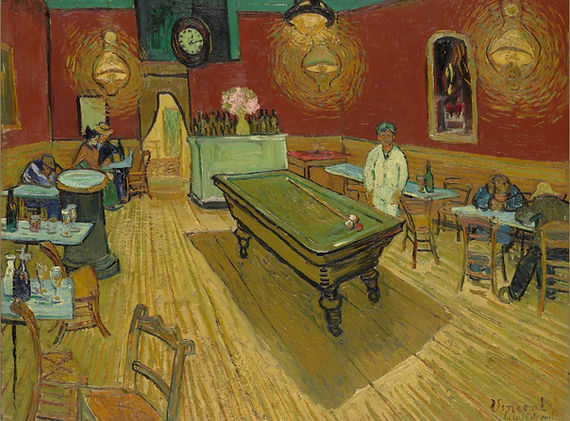
NIGHT CAFE (CAFE DE NUIT)
Vincent Van Gogh (1853-1890)
8 September 1888
Yale University Gallery, New Haven, CT, United States
Vincent Van Gogh wrote to his brother Theo (August 1888): “Today I will probably start on the interior of the inn where I’m lodging...it is what we call a cafe de nuit (they’re common here), which stays open all night. Nighttime wanderers can find a refuge – it’s an asylum – when they don’t have the means to pay for a room or are too drunk to be allowed in.” The cafe is quiet and the harsh gas lighting accentuates the sadness of the setting. Under the eye of the waiter, a couple and a few tired customers kill time, alone, long into the night. Wine and absinthe sit together on the shelf.
Van Gogh added, a month later: “I wanted to show that the cafe is a place where one can destroy oneself, go mad, commit crimes. I did this by using contrasts of soft pinks, reds and crimsons; pale and Veronese greens clash with yellowish and bluish chrome greens, together producing an infernal, sulfurous atmosphere, expressing the shadowy power of an assommoir.” Van Gogh’s expressionism strongly foreshadows the artist’s eventual perdition. Several months later, he succumbed to a spell of madness and attacked Gaugin, who had come to Arles at his invitation. Almost two years later, he would commit suicide almost two years later at Auvers-sur-Oise.
19TH CENTURY

WOMEN ON THE TERRACE OF A CAFE IN THE EVENING Edgar Degas, pastel on monotype, 1877 - Musée d'Orsay, Paris / 1

AT CAFE Auguste Renoir, c. 1877 - Kröller-Müller Museum, Otterlo, The Netherlands

AT CAFE LE BOUCHON (unfinished) Edouard Manet, 1878/79 - Musée Pushkin Museum, Moscow / 3
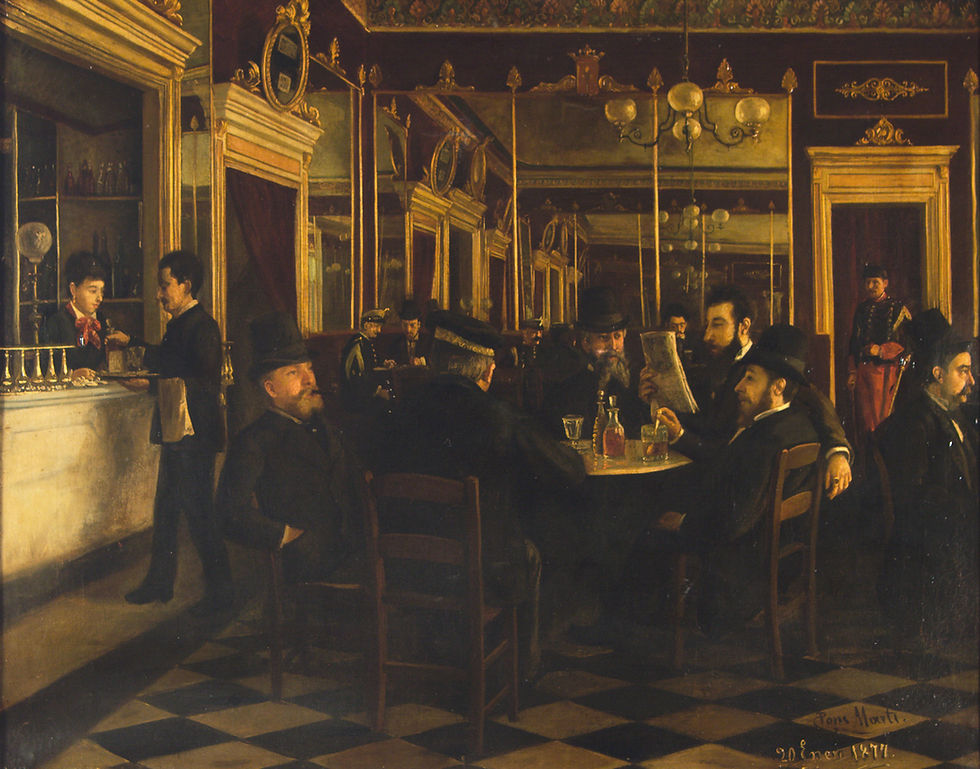
CAFE VILA (In Gironia, Catalonia) Jaume Pons Martí, 1877 - Girona Art Museum, Spain

AT CAFE (AU CAFÉ) Gustave Caillebotte, 1880 - Rouen Fine Arts Museum, France / 5
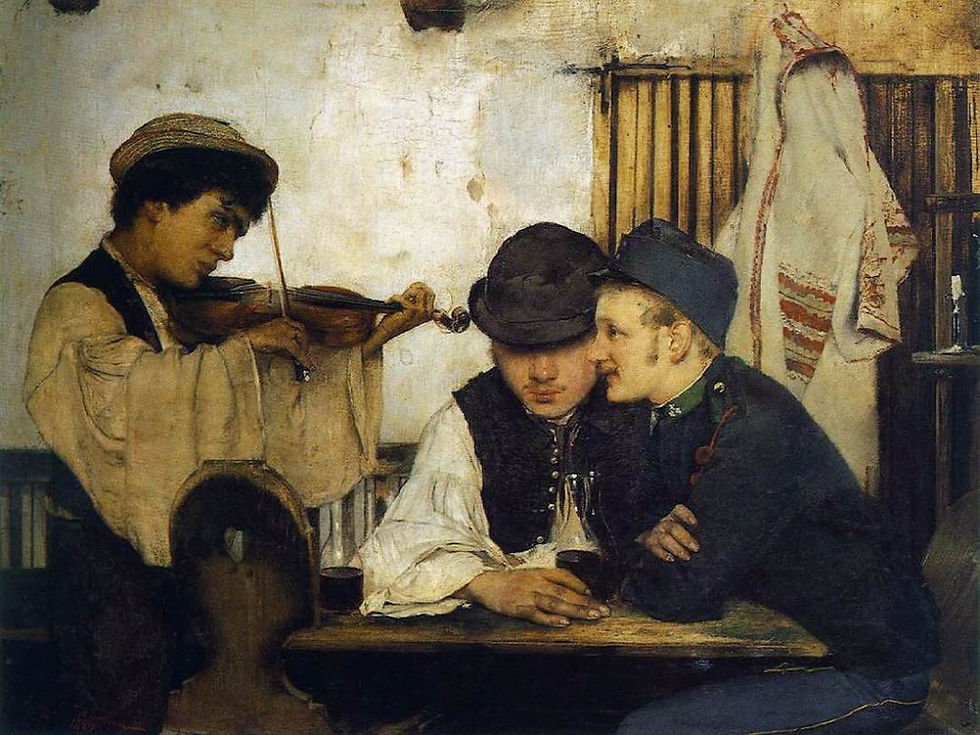
GOOD WINE Simon Hollosy, 1884 - Magyar Nemzeti Galéria, Budapest, Hungary
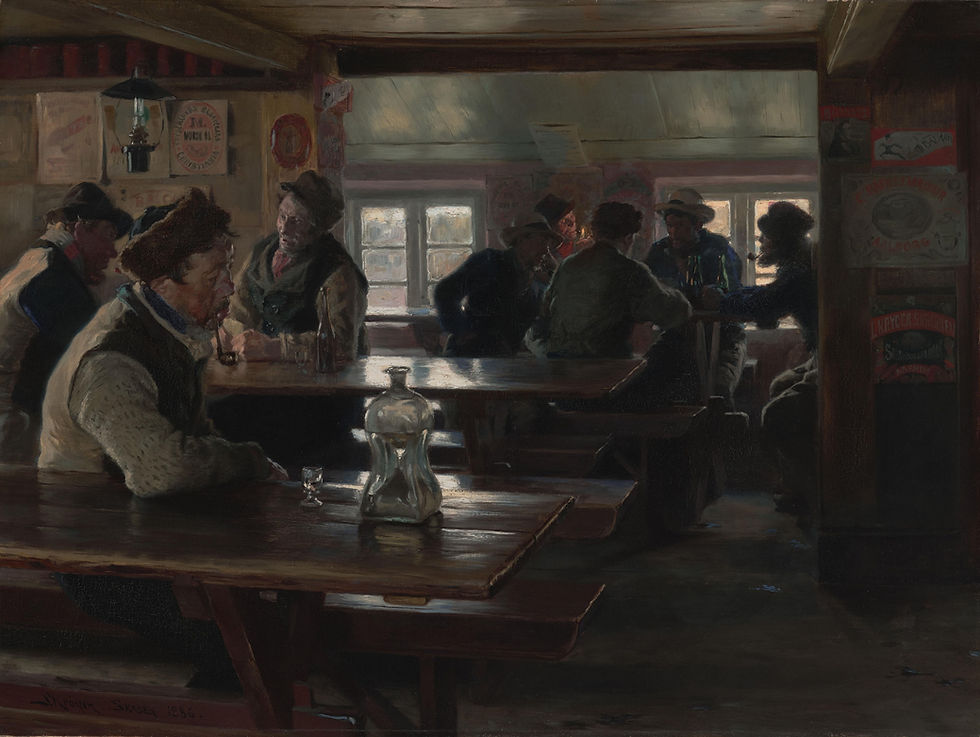
TAVERN INTERIOR Peder Severin Krøyer, 1882 - Philadelphia Museum of Art, United States
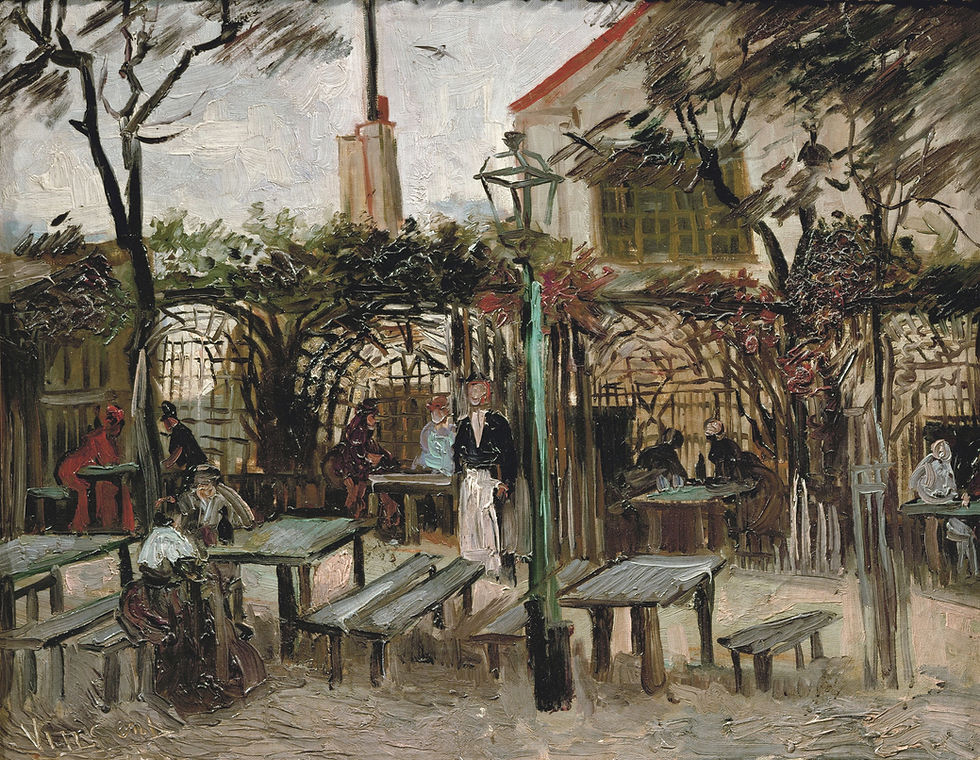
TERRACE OF A CAFE ON MONTMARTRE (LA GUINGUETTE) Vincent Van Gogh, 1886 - Musée d'Orsay, Paris

CAFE TERRACE AT NIGHT Vincent Van Gogh 16 September 1888 - Kröller-Müller Museum, Otterlo, The Netherlands
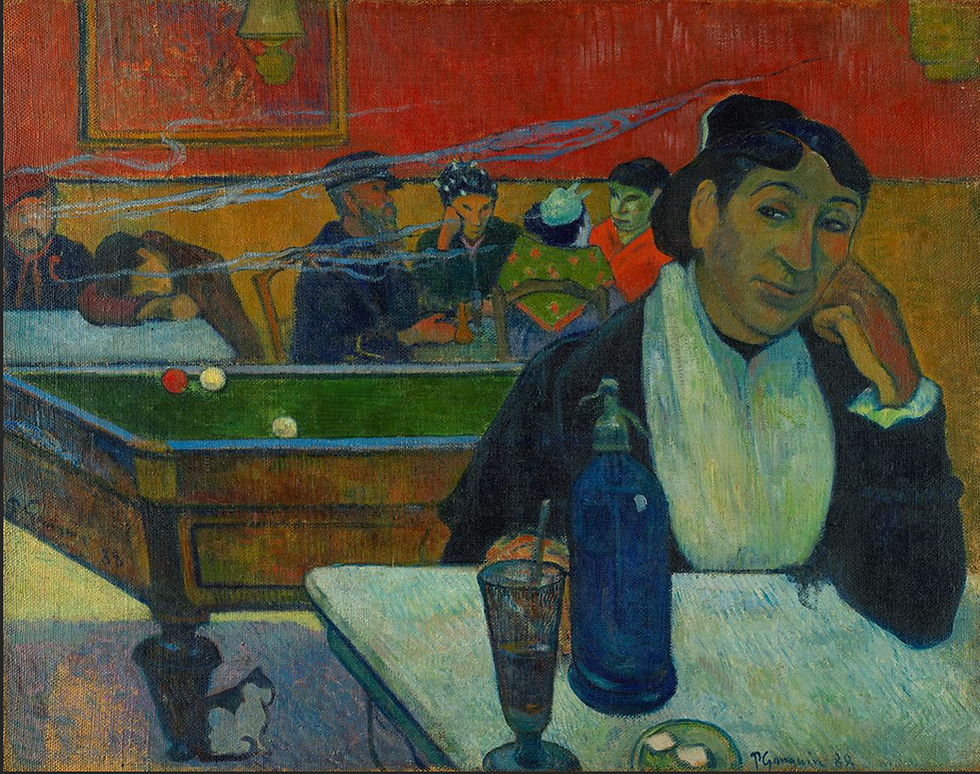
NIGHT CAFE AT ARLES, MADAME GINOUX Paul Gauguin, 1888 - Pushkin Museum, Moscow / 10
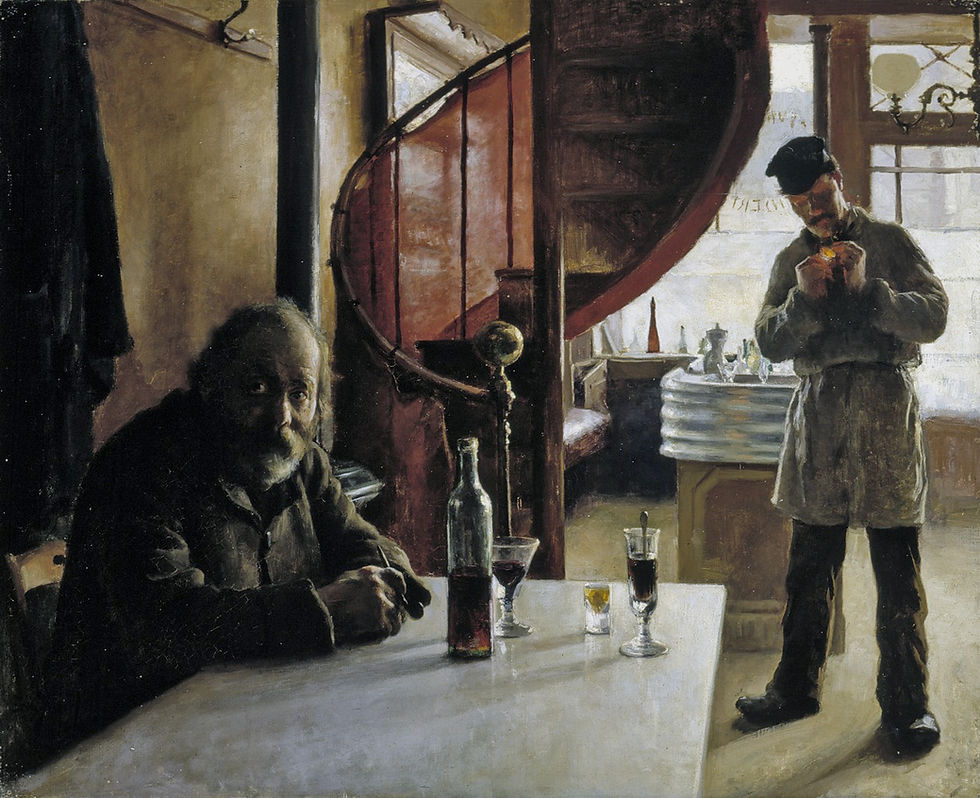
THE WINE MERCHANT LEFRANC, BOULEVARD CLICHY, PARIS Eero Järnefelt, 1888 - Athenemin Taidemuseo, Helsinki, Finland
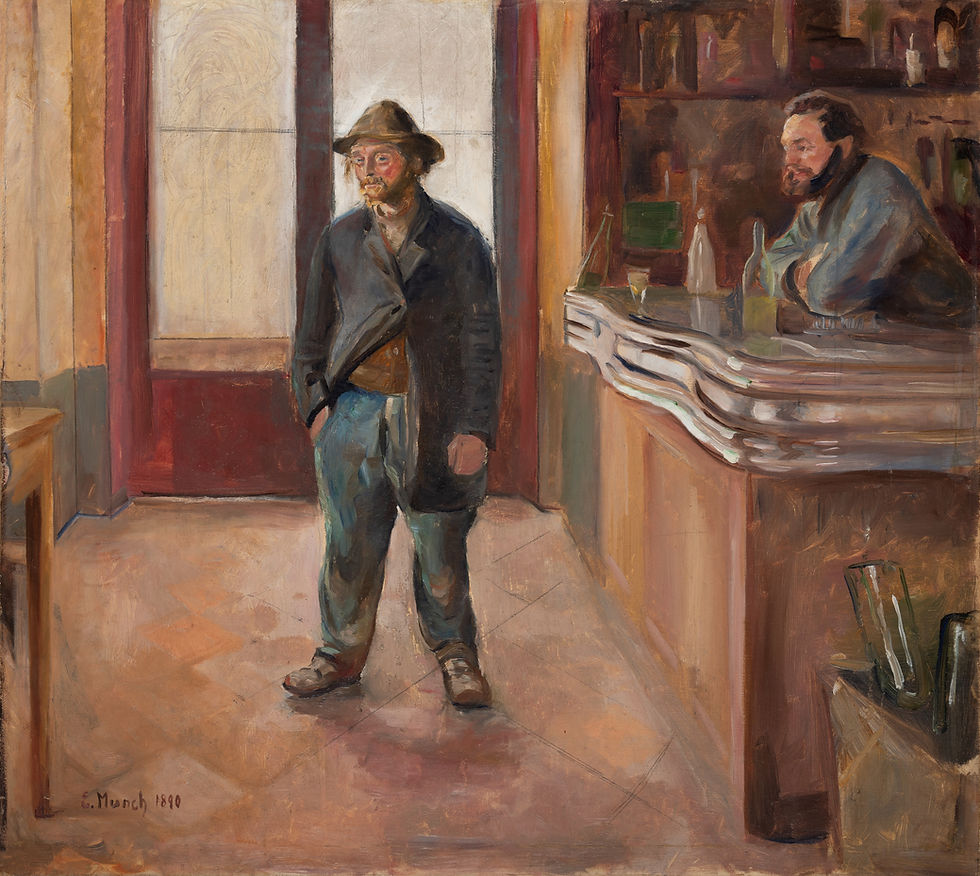
IN THE TAVERN (In St Cloud) Edward Munch, 1890 - Städel Museum, Frankfurt am Main, Germany / 12

OUTDOORS (PLEIN AIR) Ramon Casas, 1890 - Museu Nacional d'Art Contemporani, Barcelona, Spain

SMOKER Paul Cézanne, 1890/92 - Hermitage Museum, St Petersburg, Russia / 14

THE DRINKER (LE BUVEUR) Paul Cezanne 1890/1900 - The Barnes Foundation, Philadelphia, PA, USA / 15
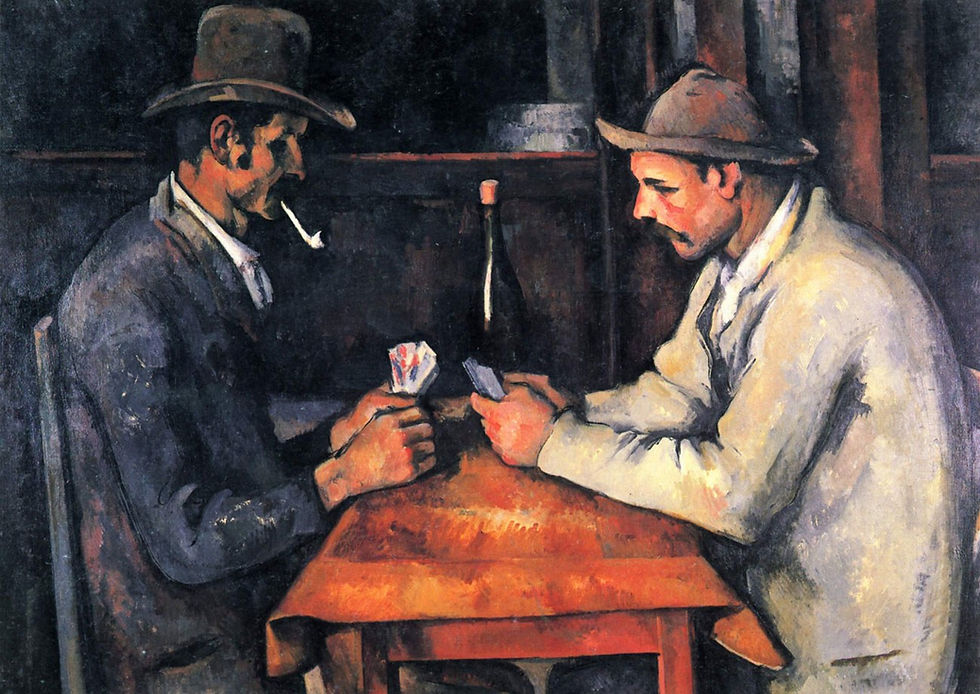
THE CARD PLAYERS (LES JOUEURS DE CARTE) Paul Cezanne, 1892/93 - Qatar's royal family / 16

THE CARD PLAYERS (LES JOUEURS DE CARTE) Paul Cezanne, 1892/95 - Musée d'Orsay, Paris / 17
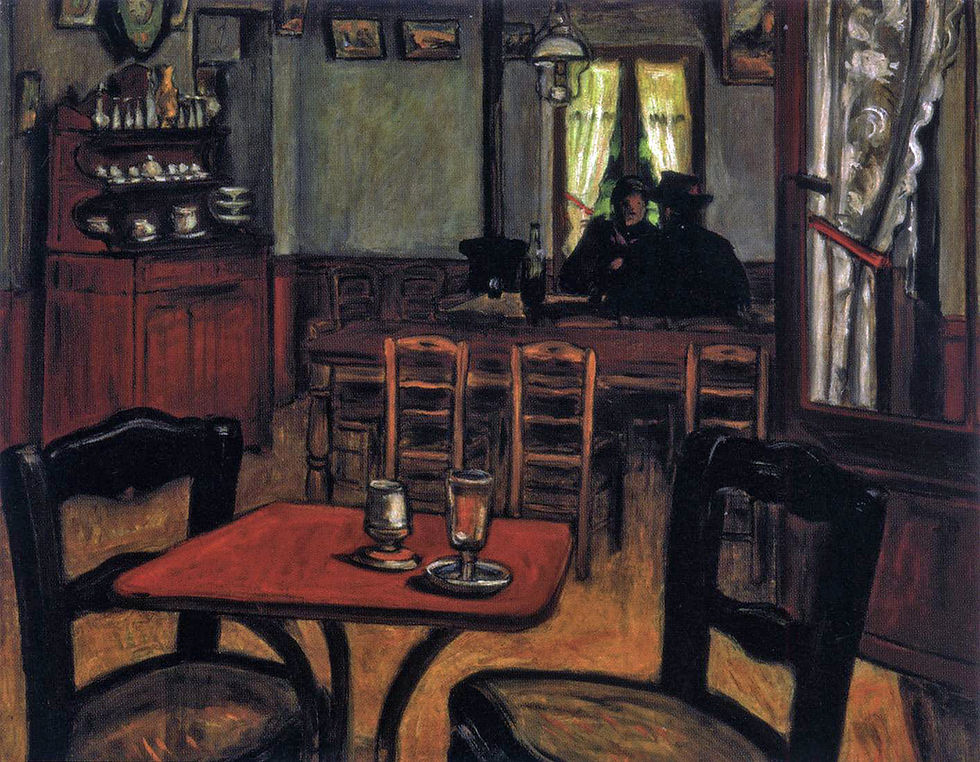
THE BIG GLASS József Rippl-Rónai, 1893 - Private Collection

MONSIEUR BOILEAU AT THE CAFÉ Henri de Toulouse-Lautrec 1893 - The Cleveland Museum of Art, Cleveland, OH, United States
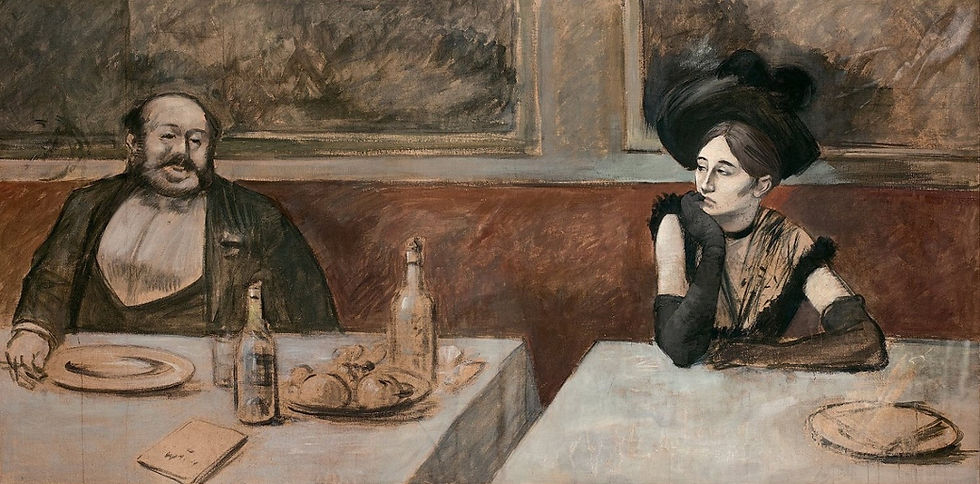
AT CAFE RICHE Jean-Louis Forain, 1894 - Private Collection / 20
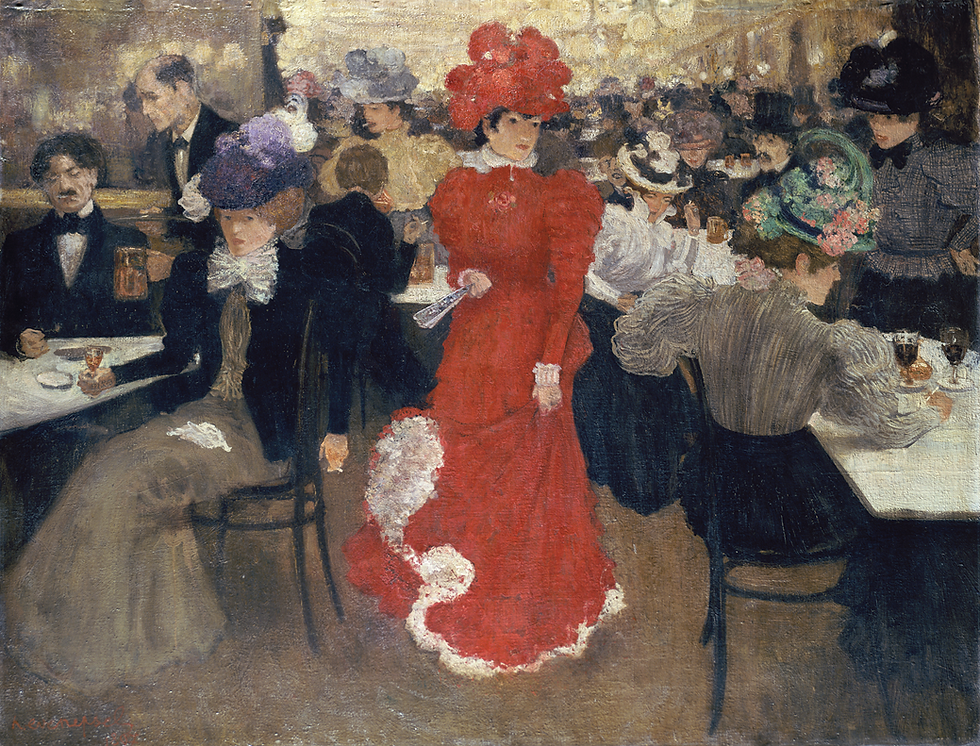
IN THE CAFE D'HARCOURT Henri Evebepoel, 1897 - Städel Museum, Frankfurt am Main, Germany

HAPPY TIME (PARTIE DE PLAISIR or CAFE)) Edouard Vuillard, ca. 1898-1899 - Private collection

CAFE SCENE (SCÈNE AU CAFÉ) Edouard Vuillard, 1899 - Neue Pinakotek, Munich, Germany

AT CAFE : THE OWNER AND THE CHLOROTIC CASHIER Toulouse-Lautrec, 1898 - Kunsthaus, Zürich, Switzerland
> Click on the icons for a closer look at the artworks
Cafes were born in the century of the Enlightenment (the 18th century). In Paris, “the salons of intelligence and the twin assets of social and intellectual distinction. Wine (still or sparking champagne, Tokay or Rhine valley wine) is rarely drunk here.” Cafes were not depicted by master painters, most of whom still had little interest in genre scenes. From the second half of the 19th century, cafes became more democratic and, under many different names (cabaret, wine merchant, mastroquet), attracted people from every social and professional rank. Anyone could be found in this type of space. A place of light, warmth and sociability, the cafe became a social melting-pot. Between the cafe walls, ‘people’ could talk, play, drink and smoke, usually in a kind of sociable anonymity.
1. Cafes and cafes concerts became a central point of urban life. Once more, it was Haussmann’s Paris which gave them this importance, as the large pavements of the boulevards, glowing under gaslights at night, allowed cafés and restaurants to flourish. In his Women on the Terrace of a Cafe in the Evening (Femmes à la terrasse d’un café le soir), Degas portrays “prostitutes, wilted, faded creatures who, sweating vice, cynically go over the events of the day” (Georges Rivière, art critic, 1877).
3. For many customers, cafés provided a substitute family and a way of killing time, like the drunken woman asleep on her neighbor's shoulder in At Cafe Le Bouchon by Edouard Manet, himself a regular of all sorts of Paris cafés.
5. This man, leaning against the table, seems like a fixture of the bar. We can see behind him a pile of four china saucers set before a glass of absinthe. This painting is a manifesto against the liberalisation of licenced establishments, set out in the law of 17th July 1880, when this extremely potent drink - absinthe’s alcohol content was labelled as 70% - was ravaging lives, particularly among the working classes, in the assommoirs of the time (Emile Zola’s novel L’Assommoir referred to the type of bars frequented by poor labourers). The fall in the price of absinthe – a glass of “green fairy” cost less than a glass of wine – coupled with the phylloxera crisis, would cause French absinthe consumption (for a population of 41 million) to rocket from 700,000 litres in 1874 to 36 million litres in 1910. The fightback against absinthe consumption would begin in earnest with a sharp rise in wine production at the start of the 20th century. Believed to cause madness and criminality amongst its drinkers, absinthe was finally banned in 1915, through the combined efforts of the Academy of Medicine, anti-alcohol leagues and the very powerful winegrowers’ unions.
10. On the 23rd October 1888, Paul Gauguin arrived at Van Gogh’s home in Arles. Night Café at Arles, Madame Ginoux is one of Gaugin’s personal interpretations of Van Gogh’s work. We see none of the desolation apparent in Van Gogh’s version of the scene. The anonymous visitors seem to shrink behind the imposing figure of Madame Ginoux , the landlady. Gaugin only dealt with the hidden side of life, preferring to paint in a way that appealed to the imagination as he also demonstrates in Grape Harvest at Arles (or Human Anguish). Paul Gaugin shows us “this [very] café that Vincent likes a lot and I somewhat less. I like it when others are there, but I still feel apprehensive. It’s a question of education and such things cannot be undone” (Paul Gauguin, Letter to Emile Bernard). While Gaugin’s painting fails to show the same uninhibited expressionism as that of Van Gogh, it portrays a person sleeping and prostitutes, both typical customers of all-night cafés.
12. For Munch, Paris was “too noisy” and “too expensive”. At the beginning of 1890, like other artists and writers, he fled the cholera epidemic which was raging in the city and moved into a small room at the Hôtel Belvedere in the suburb of Saint-Cloud. This scene is very likely set in the Belvedere’s own “tavern”. A man is shown having a drink at the bar. He looks solitary, sad and melancholic: doubtless just like Munch, who was badly affected by the sudden death of his father just a few months earlier…
14-15. These Cezanne’s figures give the impression of balance and tranquillity.
16-17. In Paul Cezanne’s The Card Players, to be found in the Musée d'Orsay and also in Qatar*, the bottle, on which the light is playing, becomes the central axis of the composition, separating the space into two symmetrical areas and thus highlighting the opposition of the card players. Cezanne used as models peasants whom he had seen on the Jas du Bouffan family estate, near Aix-en-Provence. The two men, in Sunday best, have not taken off their hats. They seem to be frozen and concentrated on their game. Although impossible to identify, the cafe seems to be of the most basic sort, featuring a wooden table covered with a short tablecloth, ordinary chairs, a simple bottle of wine. Only a mirror on the wall adds to the decor.
20. The dinner and the diner is a recurring theme among artists of the so-called “Belle Époque”. Whether in a café or restaurant, all have tried it. With characters joyful, miserable, provocative, drunken, full or ravenous, all have skilfully covered this slice of life. The thing that strikes us about the couple here is the feeling of solitude. They’re there together, but their eyes never meet: each is in their own world; the other doesn’t count or, if they do, it’s only because one of the characters hopes to take advantage of the other in some way. Two wordless stories unfold.
A frontier is created by the empty space between the tables: to the right, the large, lusty and full-looking bourgeois gentleman is waiting for his bill, while to the left, the thin and hungry lorette [a term for young women of light morals of the time] waits, with little conviction, for someone to buy her dinner. [Editor’s note: We can easily imagine this woman casting a look of disdain at her neighbour.] … “Le Riche” was one of the great Boulevard cafés and, like all of them, also a restaurant. The literati, newspapermen, painters, musicians and other great minds met there… Nights here could take a naughty turn, with private rooms upstairs (Source: Beaussant Lefevre auction catalogue).
* Several versions of The Card Players were produced by Cezanne: five copies are conserved at the Musée d'Orsay, the Courtauld Institute of Art in London, New York’s Metropolitan Museum of Art and the Barnes Foundation in Philadelphia. As for the fifth known copy, it was bought privately by the Qatari royal family for 228 million Euros, making it the most expensive painting in 2012! This sad record has been beaten. This version and those of the Musée d'Orsay and the Courtauld Institute are the only three to feature wine and just two characters. The Qatar version was finished before that of the Musée d'Orsay, and is two and a half times bigger (97 x 130 cm vs. 47.5 x 57 cm).
20TH CENTURY

THE BAR COUNTER (SUR LE ZINC) Maurice Vlaminck, 1900 - Calvet Museum, Avignon, France

EL PARALELO CAFÉ CONCERT (Barcelona, Spain) Pablo Picasso, 1900/01 - National Picasso Museum, Paris
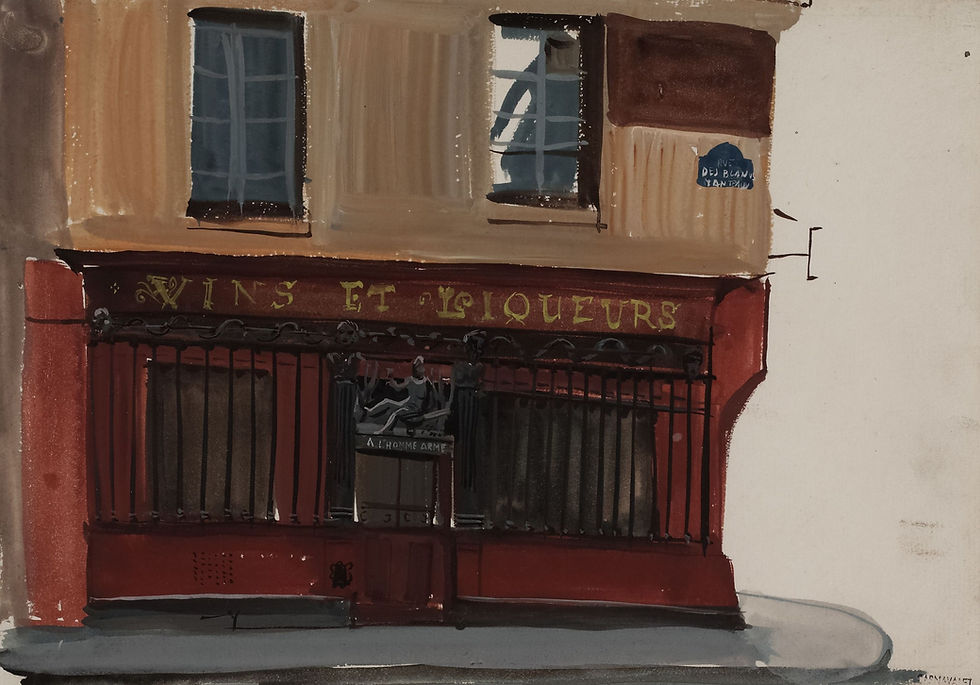
'AT THE ARMED MAN' Unknown artist, beginning 20th century? - Carnavalet Museum, Paris

NOTRE-DAME, SUN Albert Marquet, 1905 - Fine Arts Museum, Pau, France

THE BAR WITH BOATERS Auguste Elisée Chabaud, ca. 1808 - Private collection

LITTLE LINA Charles Camoin, 1907 - Cantini Museum, Marseille, France

CAFE MAXIME, PARIS Jean-Louis Forain, Private collectio,

'MANILLE' PLAYERS (JOUEURS DE MANILLE) José Louis Engel Garry, bef. 1917 - Fine Arts Museum, Libourne, France

THE CARD PLAYERS Marius Borgeaud, 1917 - Private collection
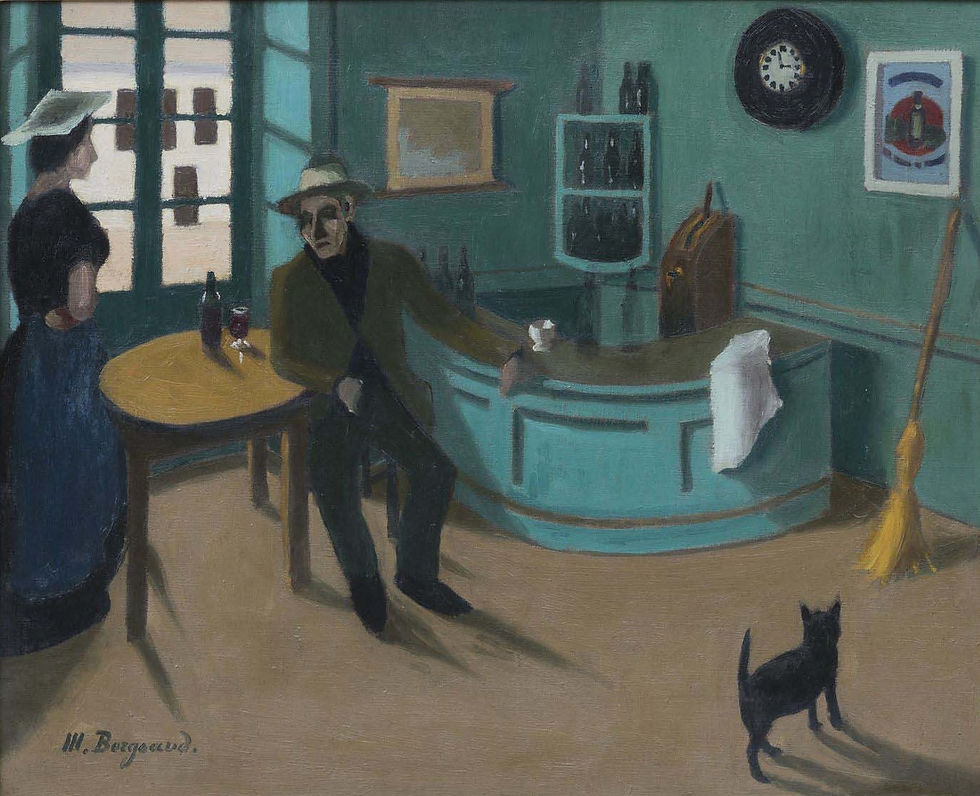
GREEN BAR Marius Borgeaud, 1018 - Private collection

SIEROUSLY WOUNDED, AT CAFE (Le Faouet, Britanny, France) Marius Borgeaud, 1921 - Hermitage Foundation, Lausanne, Switzerland

AT CAFE Edward Hopper, 1906/07 - Whitney Museum, New York

WOMAN SEATED AT CAFÉ Edward Hopper, 1906/07 - Whitney Museum, New York

COUPLE DRINKING Edward Hopper, 1906/07 - Whitney Museum, New York

THE BISTRO or THE WINE SHOP Edward Hopper, 1909 - Whitney Museum, New York / 15
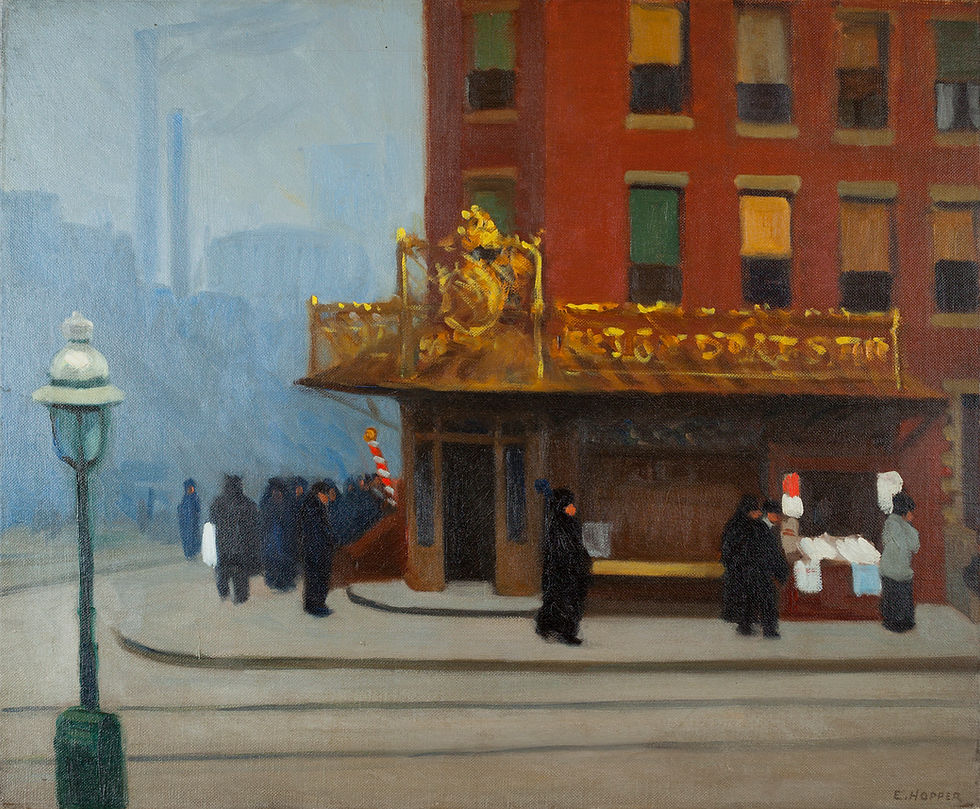
NEW YORK CORNER (SALOON CORNER) Edward Hopper 1913 - Cantors Arts Center, Stanford University, CA, United States

SOIR BLEU Edward Hopper, 1914 - Whitney Museum, New York
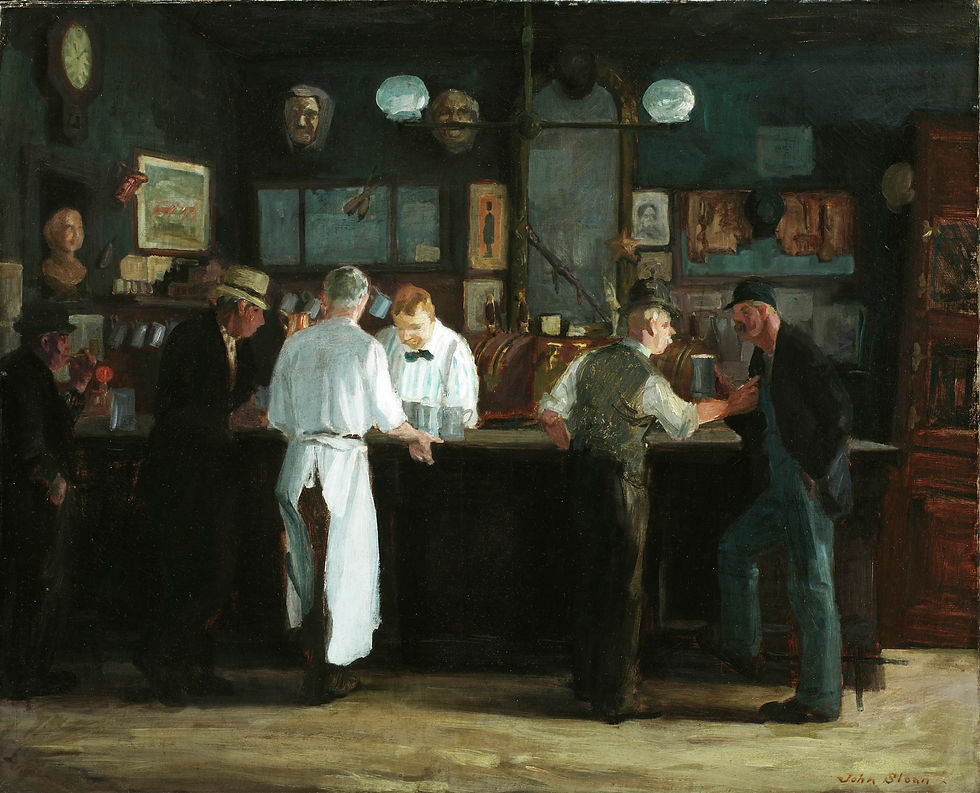
McSORLEY'S BAR (NYC) John Sloan, 1912 - Detroit Institute of Arts, Detroit, MI, United States
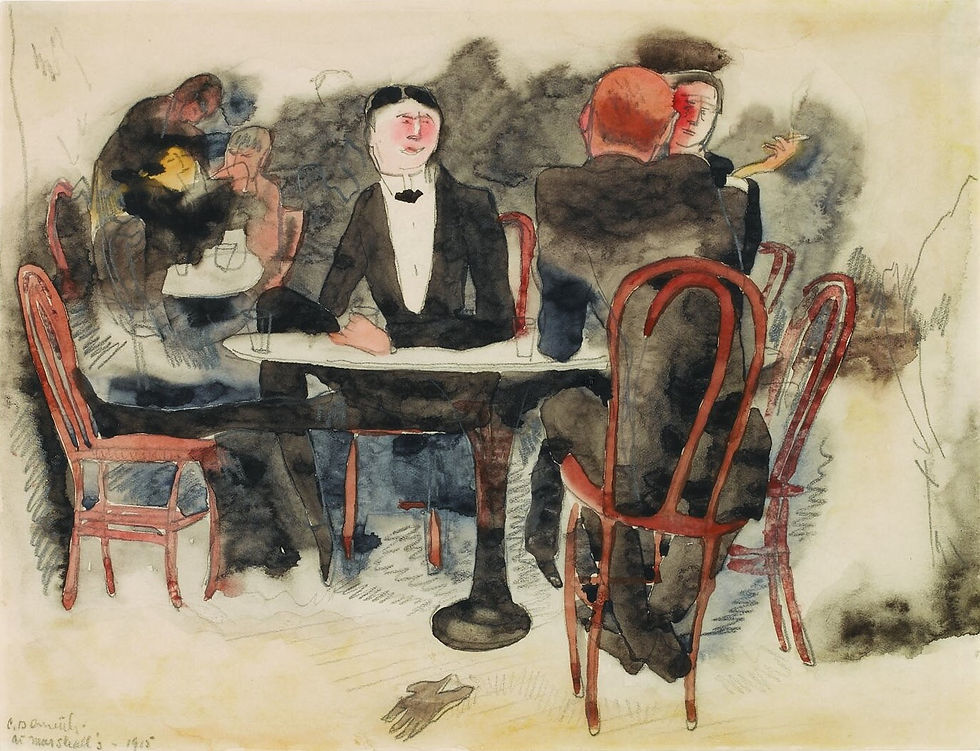
AT MARSHALL'S Charles Demuth, 1915 - Demuth Museum, Lancaster, PA, United States

THE CAFE TERRASSE Diego Rivera, 1915 - The Metropolitan Museum of Art, New York City

THE CAFE Mabel Frances Layng (English) 1925 - Shire Hall Gallery (fermée), Stafford, United Kingdom

THE CAFE TERRACE (LA TERRASSE) Ossip Zadkine, 1920 - Private collection / 22

MAN WITH A WINE GLASS Amedeo Modigliani, 1918 - Private collection / 23

THE GUITAR PLAYER (LE JOUEUR DE GUITARE) Ossip Zadkine, 1920 - Paris Museum of Modern Art, Paris / 24

TWO DRINKERS LEANING ON THE BAR Ossip Zadkinen 1922 - Museum of Modern and Contemporary Art, Strasbourgn France

AT CAFE (AU CAFÉ) Ossip Zadkine, 1921 -Nash collection, London

CUBIST COMPOSITION (WAITER IN A CAFE) Fernand Léger, 1920 - Private collection
> Click on the icons for a closer look at the artworks
15. One of Edward Hopper’s ‘Parisian’ paintings, Le Bistro or The Wine Shop, was painted ‘from memory’ in the USA in 1909. We are on the banks of the Seine, not far from a bridge which might be the Pont-Neuf.
22. Ossip Zadkine often made reference to the cafes, particularly those of Montparnasse: doubtless these included the smoky universe of La Rotonde, a regular haunt and a place where painters, musicians and writers were known to mix. Il y retrouvait Foujita, Soutine, Max Jacob, Henry Miller... Son ami le plus proche est Modigliani avec lequel il partage les mêmes difficultés : "C'était le temps des vaches maigres pour nous deux ; on s'asseyait aux terrasses des bistrots, Modi faisait des portraits de voisins de table qu'on leur donnait pour essayer d'avoir un franc. A un certain moment, pour pouvoir vivre et aussi travailler, c'était lui, un jour, qui mendiait pour deux, le lendemain c'était moi" (Source : Zadkine, Gouaches des années 20, catalogue, Arles, 1992).
23. Modigliani liked to record his friends’ faces: he had been the portrait-painter of tout-Montparnasse. Pavement cafes were a central part of his daily life, where he procured both models and the drunkenness necessary for each new burst of inspiration.
24. Zadkine always drew attention to his characters by making them much larger than the surrounding urban landscape. In The Guitar Player , if the pavement café in the foreground is animated by the guitarist and sitting customers, the road behind is deserted, gray and lined with identical-looking houses. The undetailed, pastel-hued figures are brought to the fore by the brighter colors of the setting.
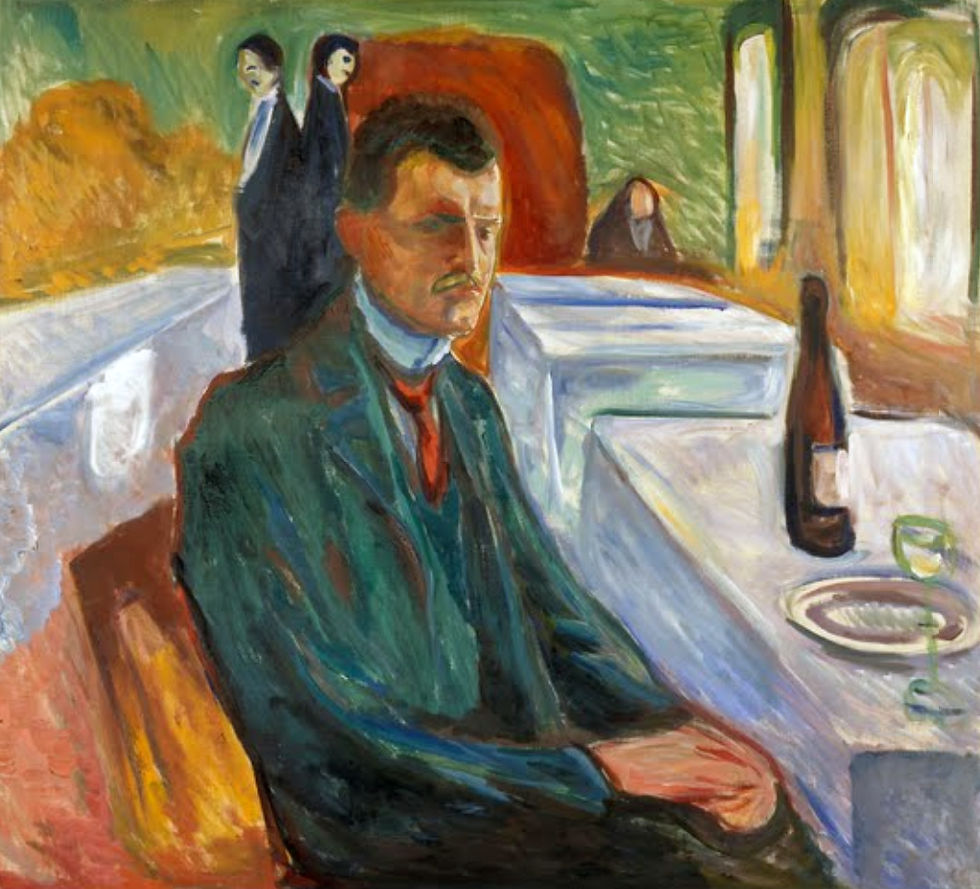
SELF-PORTRAIT WITH A BOTTLE OF WINE Edward Munch, 1906 - Munch Museum, Oslo, Norvay / 1

TAVERN Ernst Ludwig Kirchner, 1908 - Saint Louis Art Museum, MO, United States

GREEN LADY IN A GARDEN CAFE Ernst Ludwig Kirchner, 1912 - Kunstsammlung, Düusseldorf, Germany
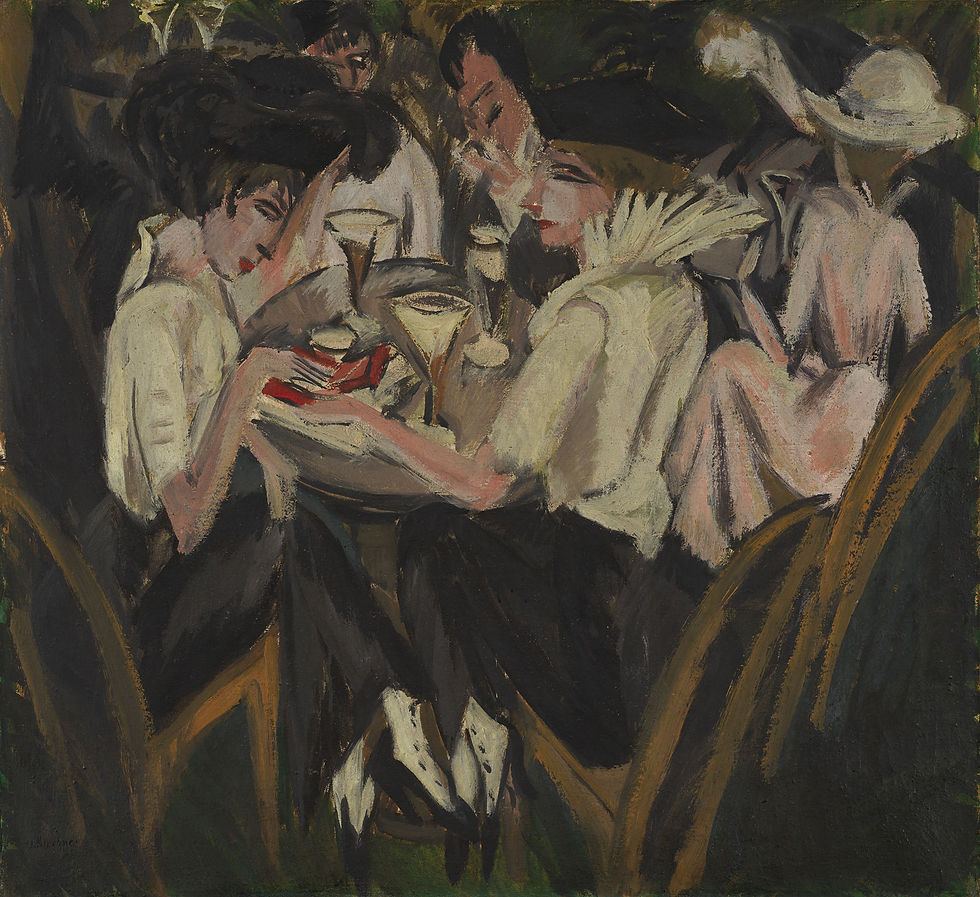
THE GARDEN CAFE Ernst Ludwig Kirchner, 1914 - Brücke-Museum, Berlin

AT THE WINE TABLE Emil Nolde, 1911 - Nolde Stiftung Seebüll, Neukirchen, Germany

WINE BAR Karl Schmidt-Rottluff, 1913 - Brücke-Museum, Berlin, Germany

CAFE, 1915 Georges Grosz, 1915 - National Museum of American History, Washington / 7

CAFÉ George Grosz, 1916 Saint Louis Art Museum (SLAM), Saint Louis, MO, United States

'GERMAN WINE AND GERMAN SONG' George Grosz, 1919 - E.W/K. Collection, Bern / Davos, Switzerland

AT CAFE George Grosz, 1922 - Private collection

THE PHILISTINE (DER SPIESSBÜRGER) George Grosz, ca. 1928 - Collection particulière / 11

SELF-PORTRAIT WITH CHAMPAGNE GLASS Max Beckmann, 1919 - Städel Museum, Francfurt, Germany
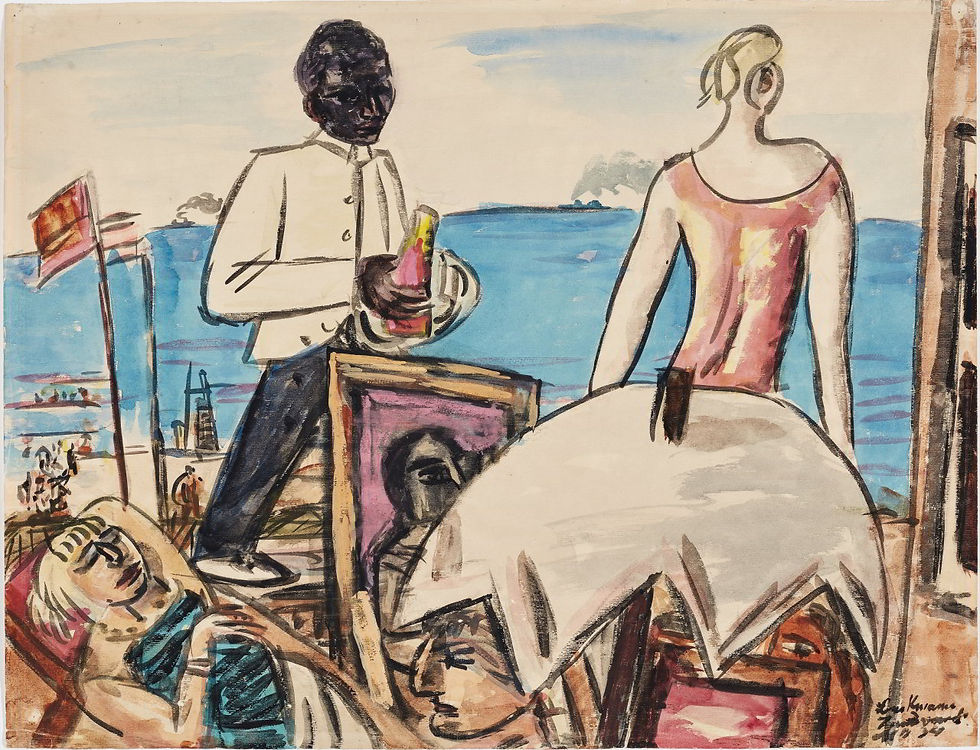
CAFE, ZANDVOORT BEACH [The Netherlands] Max Beckmann, 1934 - Kunstmuseum, Bern, Switzerland

BAR, BROWN Max Beckmann 1944 - Los Angeles County Museum of Art (LACMA), United States

BANDOL CAFE Max Beckmann, 1944 - Private Collection
> Click on the icons for a closer look at the artworks
1. Edvard Munch is weak, isolated and seems indifferent or resigned. He is shown sitting at a table in a ‘claustrophobic’ yet almost-empty cafe, inhabited by two ghostlike waiters and the outline of an old woman sketched into in the background. Munch takes the same path as Van Gogh – that of Expressionism.
7. The wartime viewpoint of a painter already Dadaist, anti-bourgeois and provocative.
11. Name used by students in Germany for the bourgeoisie, “people closed to art, culture and anything new in the world.”
Suggestion: Kurt Weill, Elisabeth Hauptmann and Bertolt Brecht, Happy End, Bilbao-Song (1929)
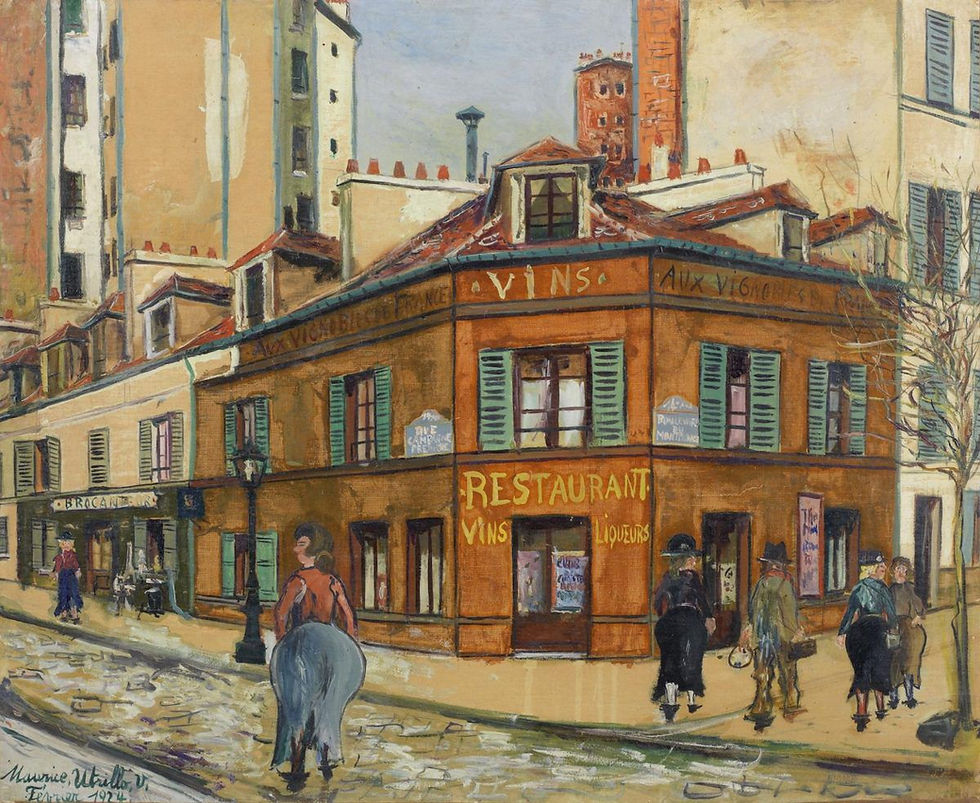
'AUX VIGNOBLES DE FRANCE', BOULEVARDS DU MONTPARNASSE A PARIS Maurice Utrrillo, 1924 - Private collection

'AUX VIGNOBLES DE FRANCE' Takanori Oguiss, 1922 - Private collection
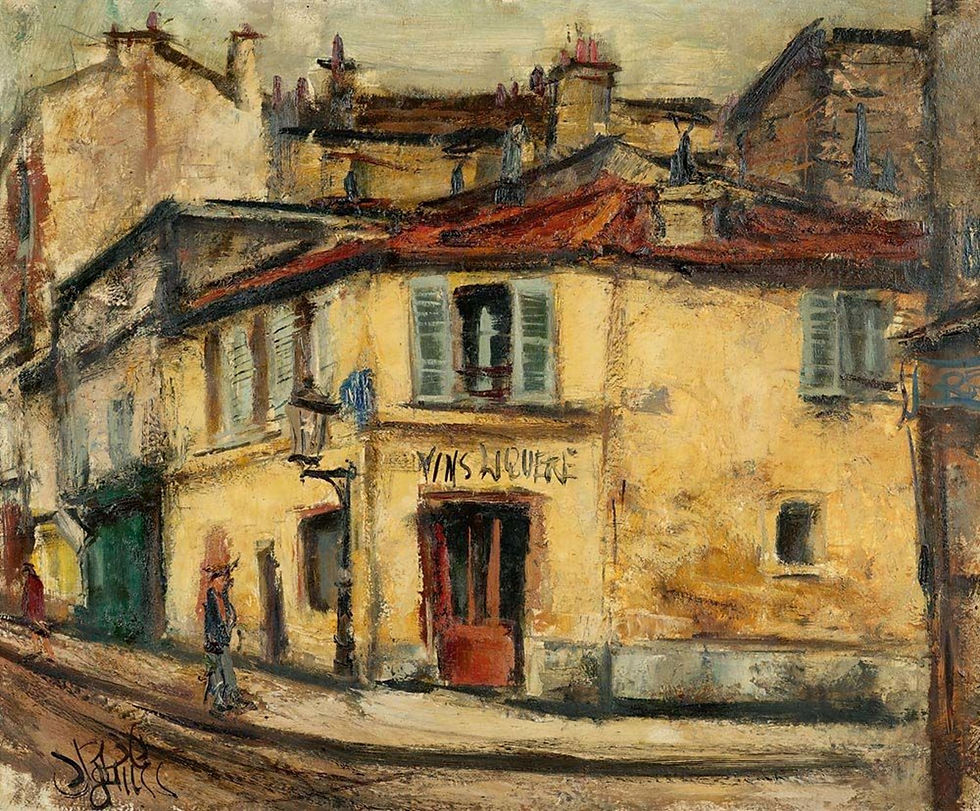
"VINS LIQUEURS' Takanori Oguiss, 1930 - Private collection

PETIT POUCET CAFE (LE CAFÉ AU PETIT POUCET) Pierre Bonnard, 1928 - Pompidou Center, Paris

COMPOSITION Mark Rothko, 1929/31 - Collections of Kate Rothko Prizel and Christopher Rothko
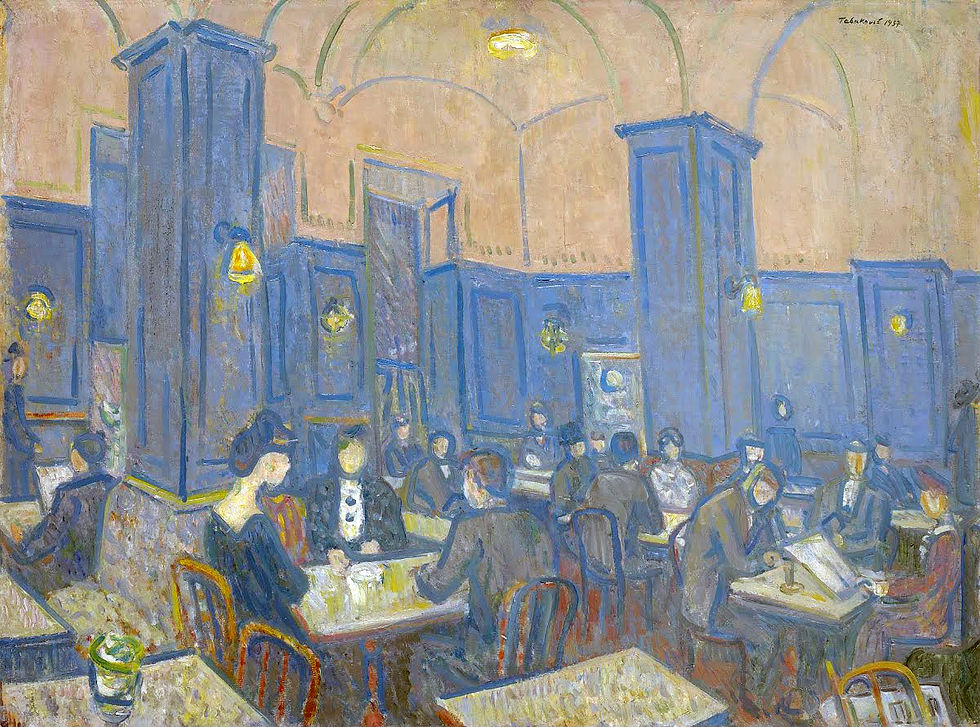
BLUE CAFE Ivan Tabaković, 1937 - The Pavle Beljanski Memorial Collection, Novi Sad, Serbia

A COUPLE AT CAFE Pierre de Belay, 1932 - Fine Arts Museum, Quimper, France

THE DRINKER Pierre de Belay, 1936 - Fine Arts Museum, Brest, France
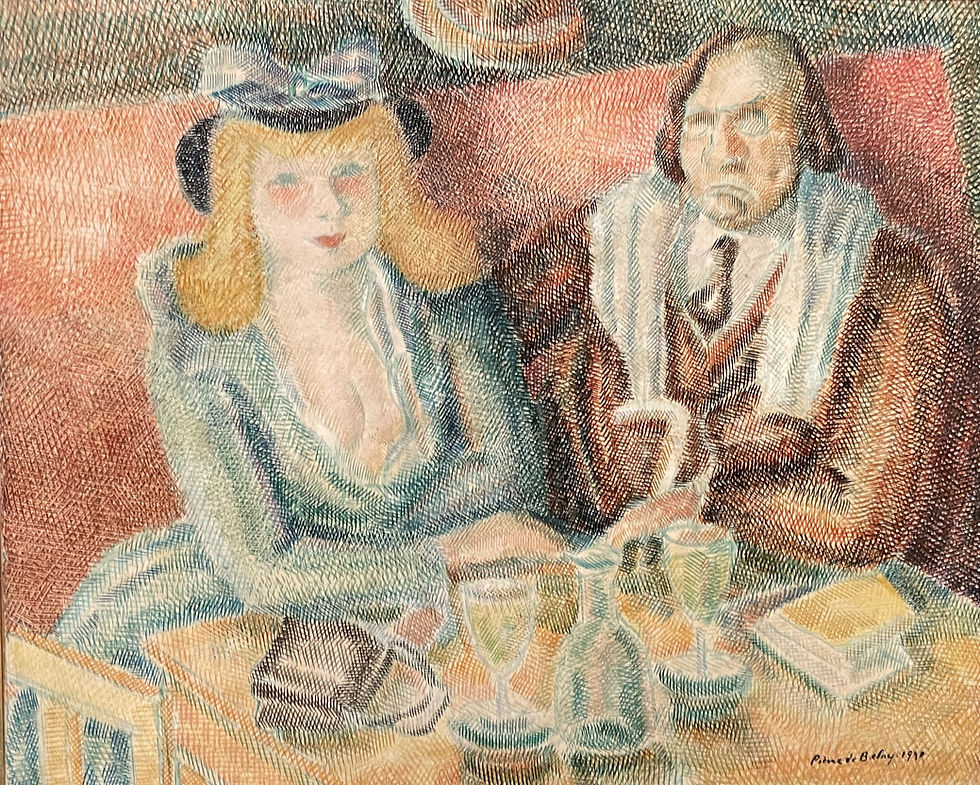
AT CAFE WITH PAUL FORT Pierre de Belay, 1940 - Fine Arts Museum, Quimper, France / 9
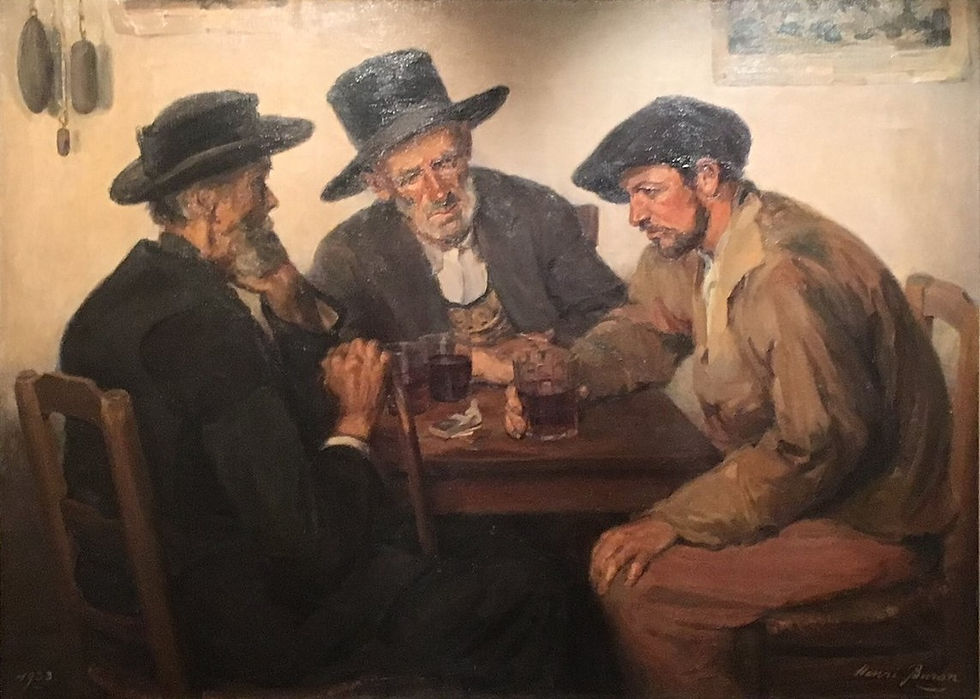
AT DRINKING ROOM Lucien-Henri Buron, 1933 - City Museum, Le Faouët, Brittany, France

CAFE Yasuo Kuniyoshi, 1937 - Whitney Museum, New York

WOMAN AT A CAFÉ Charles Réal, 1930s? - Fine Arts Museum, Menton, France
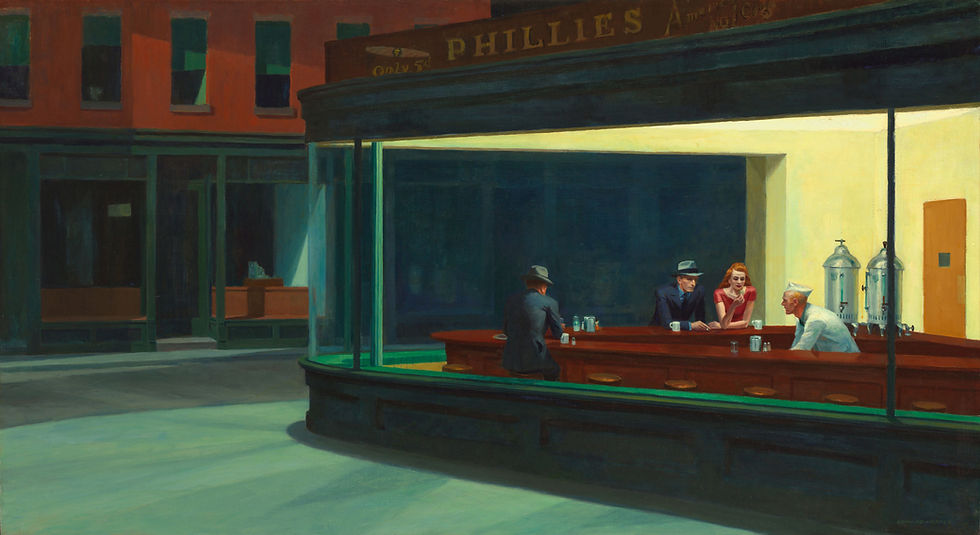
NIGHTHAWKS Edward Hopper, 1942 - Art Institute of Chicago / 13
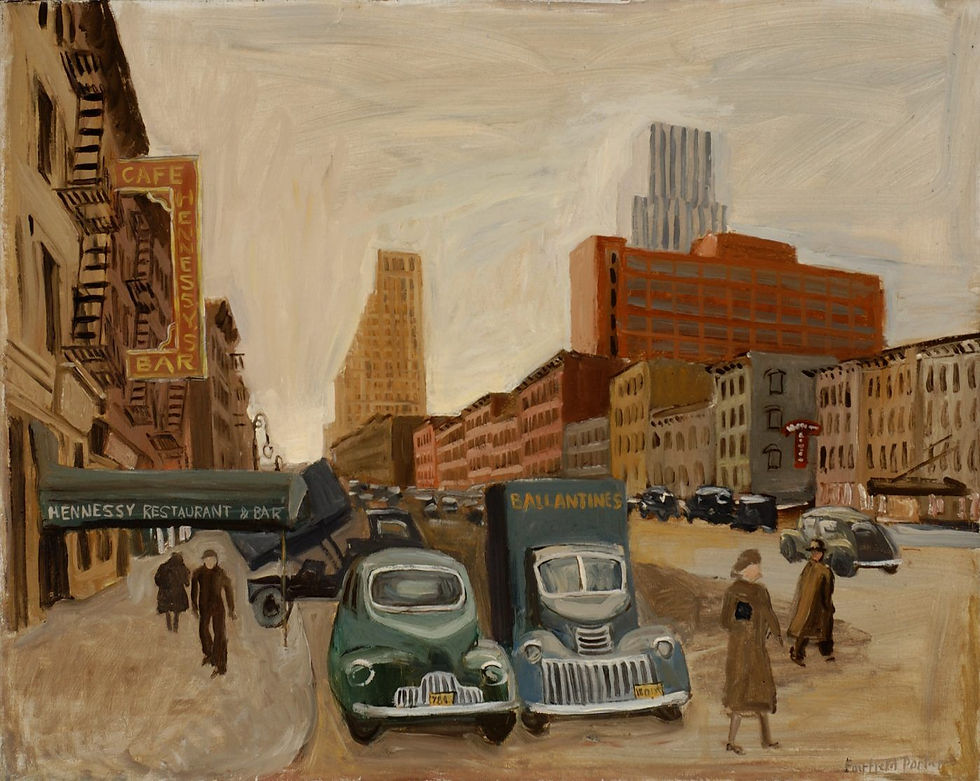
HENNESSY'S BAR Fairfield Porter, ca. 1945 - Parrish Art Museum, New York

WINE AND LIQUORS Fairfield Porter, 1980 - Parrish Museum, New York
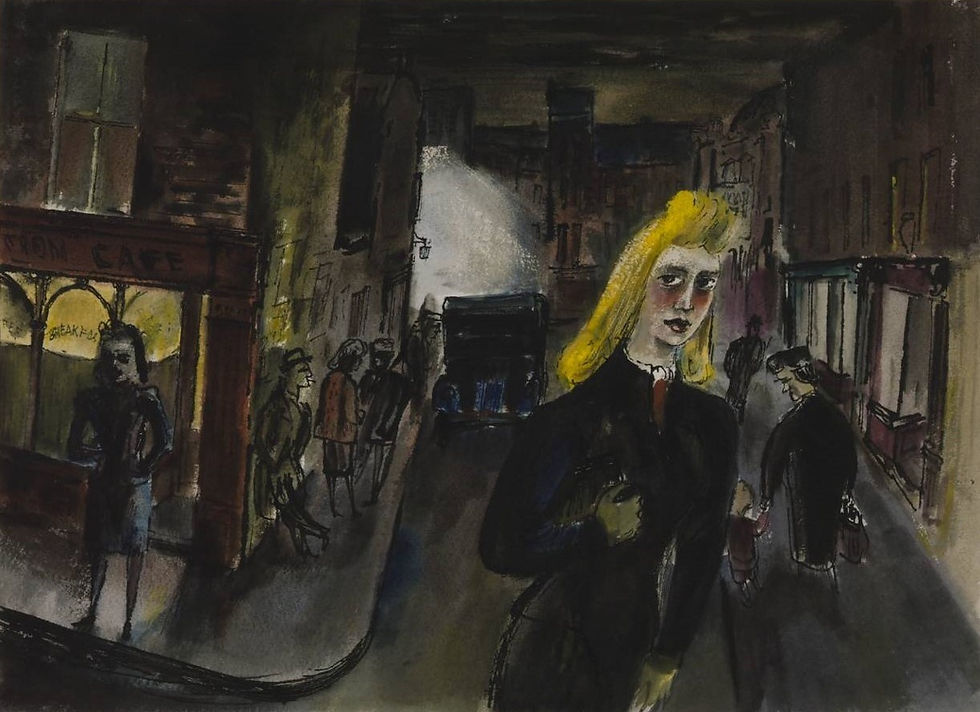
CAFE, KENTISH TOWN [Northwest London] James Boswell, 1947 - Tate Modern, London
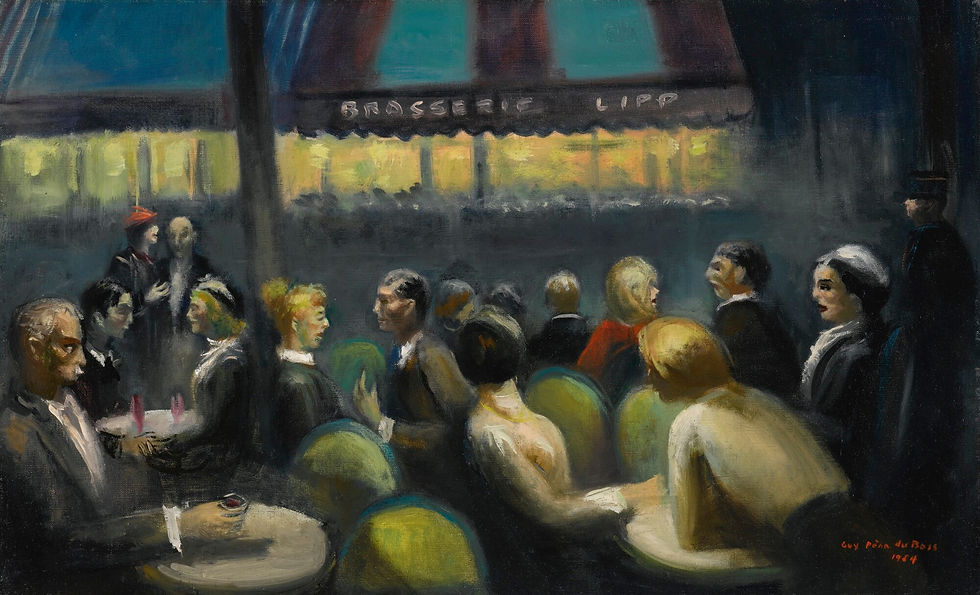
CAFÉ DE FLORE (Saint-Germain des Prés, Paris) Guy Pène du Bois, 1954 - Private collection
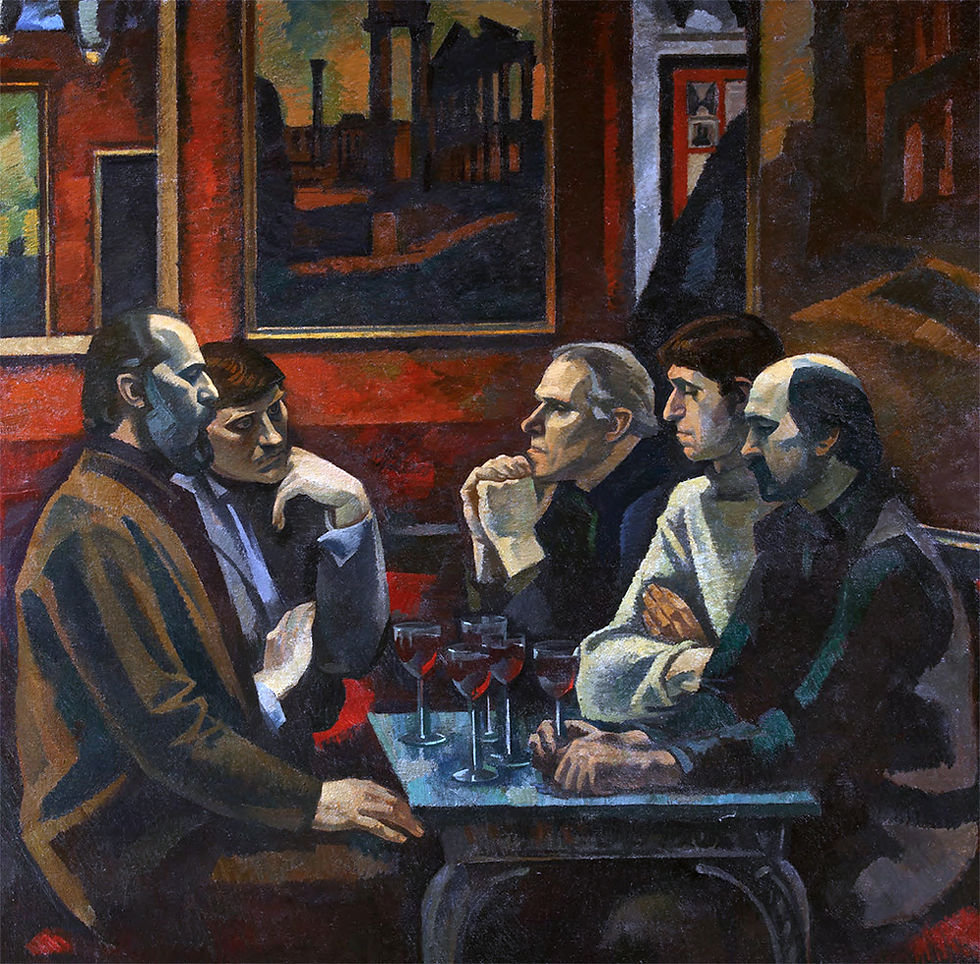
'GREKO' CAFÉ Viktor Ivanov, 1973 - The Institute of Russian Realist Art (IRRA), Moscow

WOMAN WITH GLASS OF WINE Zygmunt Bukowski ca. 1949 - Edinburgh College of Art (University of Edinburgh), Scotland

AT CAFE (AU CAFÉ) Léonard Foujita, 1949 - Pompidou Center, Paris

STREET IN PARIS Leonard Foujita, 1952 - Private collection
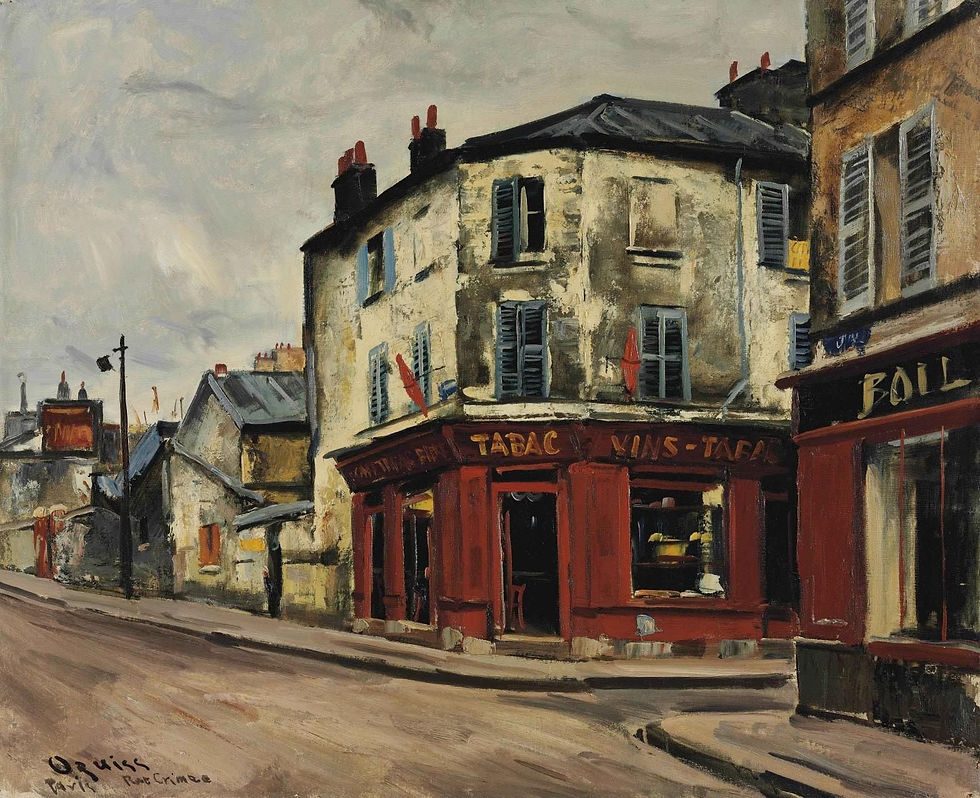
'RUE DE CRIMEE' TABAC ROUGE Takanori Oguiss, 1951? - Private collection
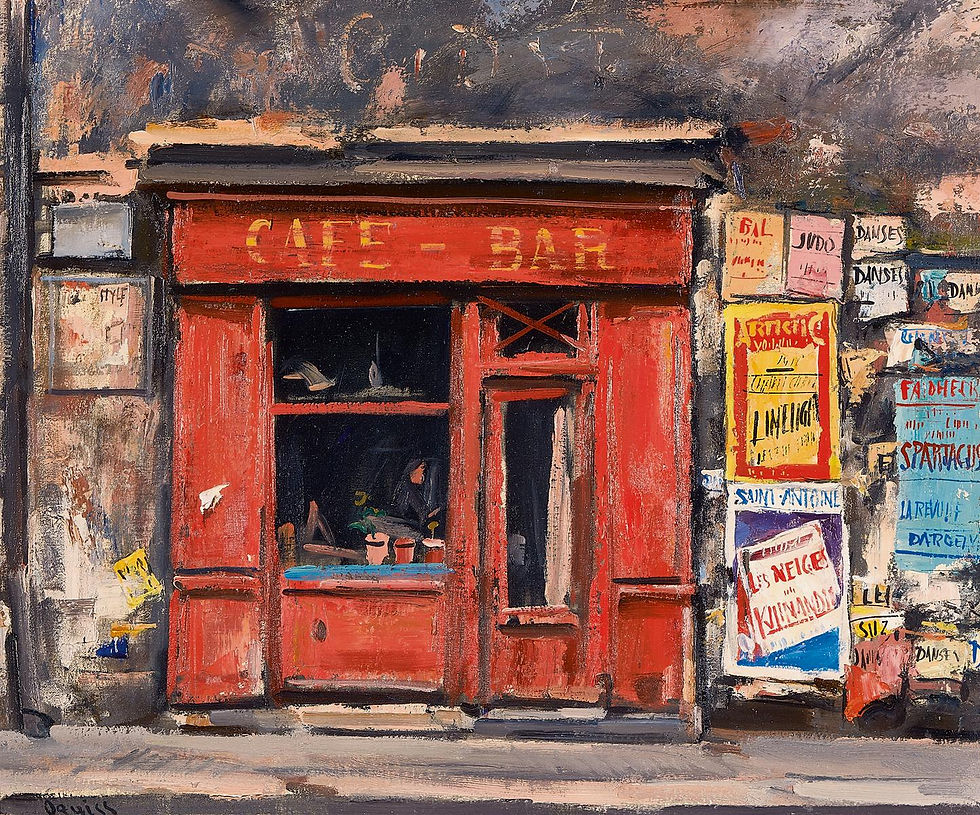
CAFE-BAR, RUE DE CHARONNE A PARIS Takanori Oguiss, 1959 - Private collection

ON THE NICE CORNER, AT MAURICE Bernard Buffet, 1970 / Watercolor, ink and pencil - Private collection

WOMAN WITH A GLASS OF WINE (FEMME AU VERRE DE VIN) Bernard Buffet, 1955 - Private collection?
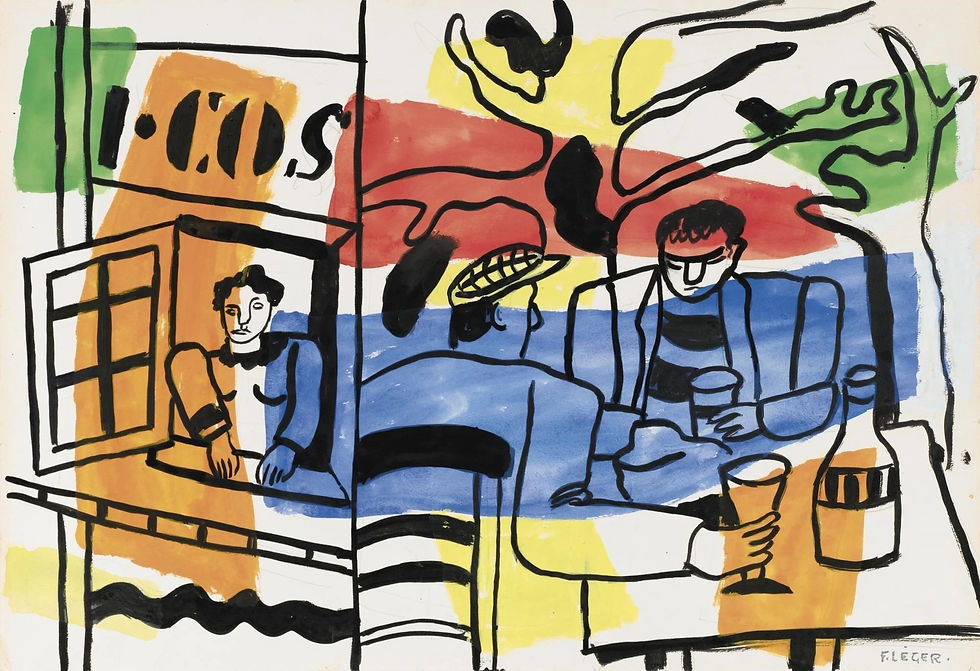
STUDY: THE CAFE Ferand Léger, gouache and ink, 1955 - Private collection
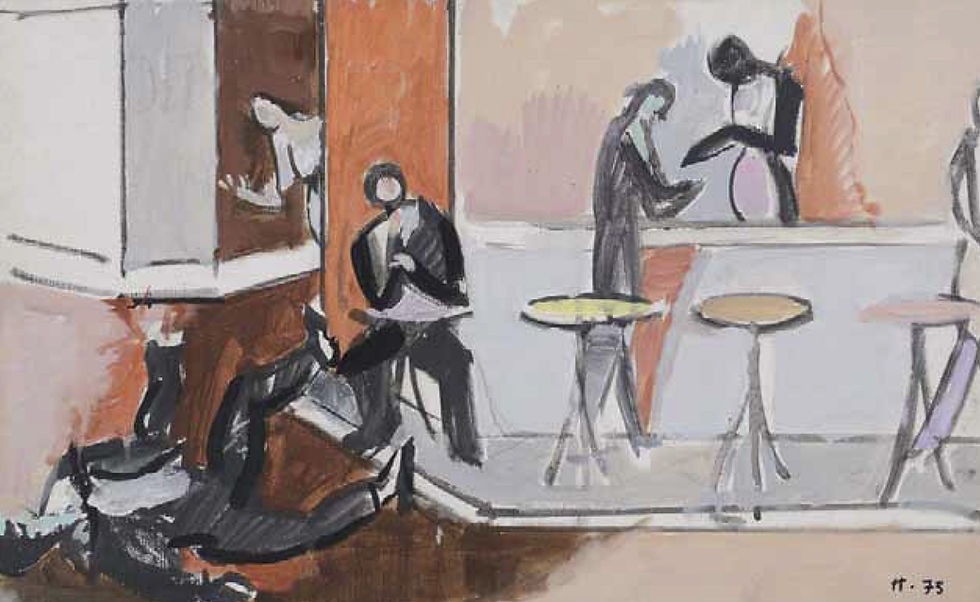
FALL IN A CAFE (CHUTE AU CAFÉ) Jean Helion, 1974 - Private collection

ANGEL GANIVET'S HOPE AND DESPAIR (ESPOIR ET DÉSESPOIR D'ANGEL GANIVET) Eduardo Arroyo, 1977 - City Museum of Modern Art, Paris

DEUTSCHLAND CAFE Jörg Immendorff, 1980 - MoMA, New York

TWO WOMEN AT THE BAR Malcolm T. Liepke, 2000 - Private collection
> Click on the icons for a closer look at the artworks
9. From 1940, Pierre de Belay used his experience as an engraver to invent a style of painting, treillisme [“trellising”], based on a repeated crisscross of cuts. Applied to a whole canvas, these coloured cut marks structured his compositions.
13. “...We believe that gathering together makes us stronger. So we do. That must be what a bar is: a place which allows bodies to be woven into the same purpose at the same moment. Being there, beholding the presence of others to believe in your own. This is a public space and you're allowed to stay.
So they're no longer alone. But gathering can make isolation worse, too. The depth of the grotto leaps out from every corner of the painting. There are four of them, a snatch of conversation, a glimpse of growing intimacy as the woman's arm brushes the man's. The waiter, there to do his job, listens once more to the nightly parade of indifferent faces...” (Francois Bon, Dehors est la ville, Edward Hopper [Outside is the City: Edward Hopper], Editions Flohic, 1998).
LOOKS CAN BE DECEIVING

Juan Gris’s Man in a Café, (1912 – Philadelphia Museum of Art), a dandy*, is drinking not wine but absinthe! This spirit was popular not just among the poor, but also among the intellectuals and "bohemians" of the time. Juan Gris was the only artist included in the Salon de la Section d’Or** of 1912, which used the ideal mathematical proportions of the golden ratio to construct compositions, as we can see in the complex system of grids and geometrical shapes making up this image/
* “The inclusion of the letters PIC and AP to the left of the man’s shoulder might be understood as a reference to Picasso, the co-creator of Cubism, and Guillaume Apollinaire, a fervent critical defender of the movement” (Source : Philadelphia Museum of Art).
** “This name was given to a group of artists, formed in 1911 and tied to Cubism, despite the absence from its ranks of the movement’s two creators: Picasso and Braque. Chronologically, the Section d’Or corresponds to the expansion of the Cubist aesthetic and represents the efforts of certain avant-garde artists to systematise the new vision which, for Braque and Picasso, was simply intuitive. The name of the Section d’Or illustrates well the group’s creative preoccupations. Following the abandonment of classical perspective in Cubist composition, the artists of the Section d'Or wanted to redivide space into two sections of the canvas according to the “golden ratio” (or “divine proportion”), the ideal relationship between two quantities. Their aim was to bring into consideration the organisation of a painting, in order to proceed methodically towards the geometric reduction of reality” (Source: Larousse).
WINE AND THE ARTS: PHOTOGRAPHY

COMPARTMENTALIZED BISTROT, PARIS Robert Doisneau, 1950

CAFE, JOINVILLE-LE-PONT, CLOSE TO PARIS Doisneau - Pompidou Center

COCO, XAVIER PRIVAS STREET, PARIS Doisneau, 1952

'LA MÔME' BIJOU, PARIS BY NIGHT Brassai, 1933
> Click on the icons for a closer look at the artworks
The Muses’ companion, wine intersects all the arts, whether literature, music, decorative or fine arts. In any case, wine is an irreplaceable witness of our social and cultural history. Although The Virtual Wine Museum is mainly concerned with painting, some examples drawn from other artistic formats allow us to illustrate this reality, to ‘bear witness’ to it. These photographs explore the same theme as this gallery.
GALLERIES AN EVERYDAY COMPANION




